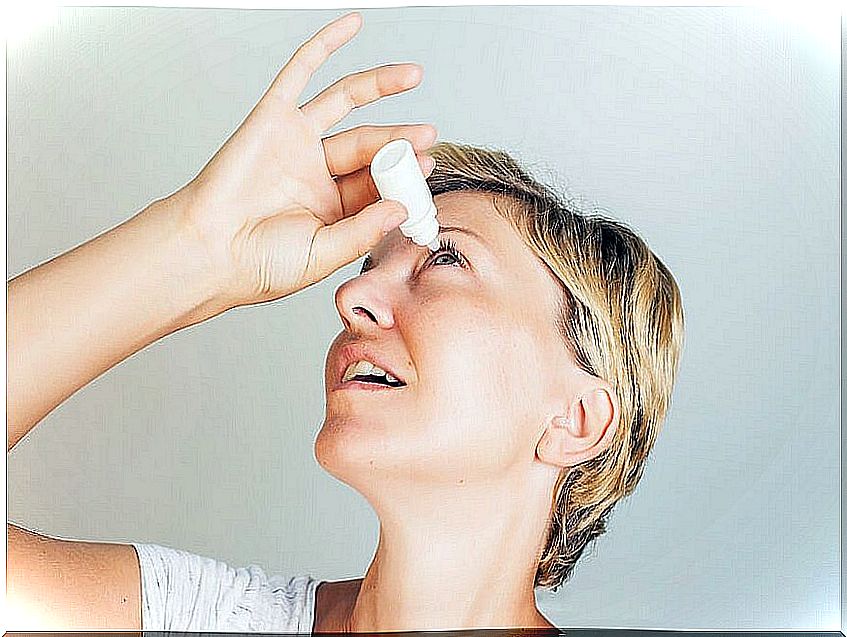6 Tips To Treat Tic Disorder In The Eye
If your eyelids are twitching or closing involuntarily, you may have a nervous tic in your eye. It is a tremor that is often accompanied by problems with vision or sensitivity to light and can occur repeatedly or in isolation.
If the tic is not severe, it can improve or even disappear with a few simple measures. Next, we will explain more about this particularity of the body scientifically known as “blepharospasm”.
Causes of tic disorder in the eye
First, it is important to try to identify the cause of this event. For this, it will be essential to go to an ophthalmologist to rule out any chronic disease.
Tics commonly appear, disappear, or change over time. Twitching in the eye can be triggered by a number of factors, from everyday situations to trauma.

According to a specialized MedlinePlus publication, the most common causes of this problem are:
- Stress.
- Lack of sleep.
- Visual fatigue
- Consumption or abuse of toxic substances such as alcohol.
Likewise, a publication of the American Academy of Ophthalmology also states that the lack of hydration in the eye, the g Olpes in the area and the use of medications for diseases such as Parkinson’s can also cause it.
Alarm symptoms
If, in addition to having involuntary spasms, you experience dizziness or blurred vision, you should go to the doctor as soon as possible, as this could be a sign of a more serious problem. Other significant symptoms that require immediate professional attention are:
- Droopy eyelids.
- Headache.
- Very slow blinking.
- Unusual discharge in the eye
- Irritation and swelling in the eyes.
How can I relieve tic disorder in my eye?
When the tics have an emotional origin, it is a possibility to opt for natural treatments, as long as the professional approves and recommends them. It can be the case of therapeutic exercises, changes in diet or doing some physical activity.
It is possible that your problem is just a passing tic and does not require a prescription for psychotropic drugs. In such a case, you can follow the following recommendations to treat it.
1. Open and close your eyes tightly
To start, put strength into blinking. Close your eyes as hard as you can, hold for 30 seconds and then open them with the same intensity. The eye will cause tearing that will help you hydrate, which could alleviate the dryness that, as we have already seen, is a possible factor causing the tic.
A much more recommended alternative is to use lubricating eye drops. In the American Academy of Ophthalmology article – cited above – this measure is suggested for the treatment of blepharospasm. You can learn more about it in point 6 of this list.
2. Massage the eye

A medical publication in the MSD Manual details that touching the face or eyes can help calm these involuntary movements. To do this, with the help of your fingertips, make circular movements on your eyelids for 20 seconds.
3. Blink
Something as simple as blinking several times in a row can reduce the discomfort caused by the tic in the eye. With this simple action, you can lubricate the eye naturally. Blinking quickly can also provide great relief.
4. Avoid stressful situations
Stress and anxiety can also cause tic disorder in the eye, as mentioned in the sources we have previously mentioned. To avoid these problems, you need to take a break from all those nerve-racking situations. Try to take things slowly and, if you consider it necessary, you can also seek professional help.
5. Rest and eat properly
The way you run your days is key to spasms. The medical publications referred to earlier speak of lack of sleep or poor rest as the cause of tic in the eye.
To avoid this problem, don’t forget to sleep at least eight hours a day. In addition, since diet and holistic well-being are closely related, it is also positive to eat a balanced diet and drink enough water. Also, try to avoid caffeine or alcohol, as they alter the nervous system.
6. Cold drops or compresses

If your eyes feel dry, consult a specialist to prescribe some drops or a special gel to hydrate. You can also follow traditional medicine recipes and do it at home and apply water or chamomile compresses.
According to a study carried out by researchers at the University of Costa Rica, chamomile has properties to reduce inflammation and cause relief in the periocular area, that is, close to the eyes.
However, keep in mind that it is necessary to have the permission of an ophthalmologist before applying this popular recipe for its application:
- First, make a chamomile tea.
- Wait for it to reach a bearable temperature.
- Then wash the area very well.
- Then, soak a compress in the infusion, or in cold water.
- Next, apply it on closed eyes and wait a few seconds.
- Then repeat, but with the hot compress, also for a few seconds.
- Do it again as many times as the ophthalmologist recommends.
Nervous tic in the eye: keep your eye doctor up to date
In conclusion, if you have any of the above symptoms or have had spasms for a while, the ideal is to go to a specialist to prevent further damage. Avoid self-diagnosis and do not resort to self-medication .
Remember that this article is only a guide for you to try to improve the problem in a natural and simple way, but you should always have the guidance and supervision of a professional.









